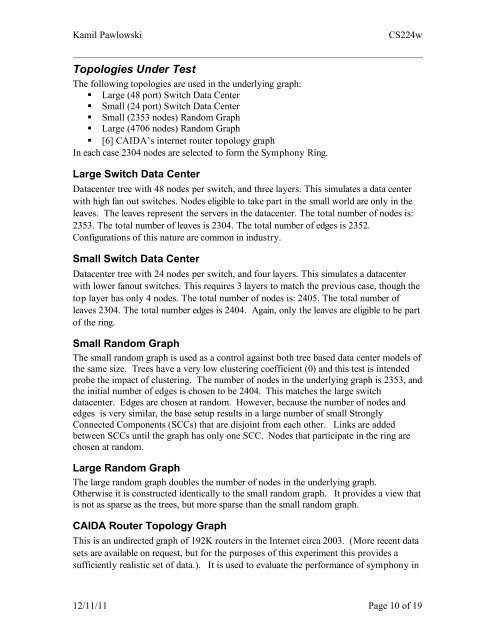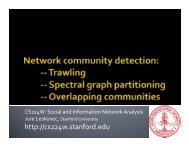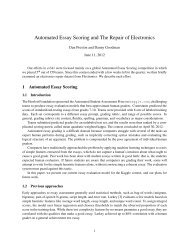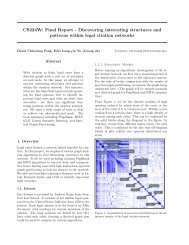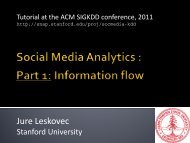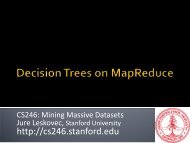Small World Overlay Networks - SNAP
Small World Overlay Networks - SNAP
Small World Overlay Networks - SNAP
You also want an ePaper? Increase the reach of your titles
YUMPU automatically turns print PDFs into web optimized ePapers that Google loves.
Kamil Pawlowski CS224w<br />
Topologies Under Test<br />
The following topologies are used in the underlying graph:<br />
Large (48 port) Switch Data Center<br />
<strong>Small</strong> (24 port) Switch Data Center<br />
<strong>Small</strong> (2353 nodes) Random Graph<br />
Large (4706 nodes) Random Graph<br />
[6] CAIDA’s internet router topology graph<br />
In each case 2304 nodes are selected to form the Symphony Ring.<br />
Large Switch Data Center<br />
Datacenter tree with 48 nodes per switch, and three layers. This simulates a data center<br />
with high fan out switches. Nodes eligible to take part in the small world are only in the<br />
leaves. The leaves represent the servers in the datacenter. The total number of nodes is:<br />
2353. The total number of leaves is 2304. The total number of edges is 2352.<br />
Configurations of this nature are common in industry.<br />
<strong>Small</strong> Switch Data Center<br />
Datacenter tree with 24 nodes per switch, and four layers. This simulates a datacenter<br />
with lower fanout switches. This requires 3 layers to match the previous case, though the<br />
top layer has only 4 nodes. The total number of nodes is: 2405. The total number of<br />
leaves 2304. The total number edges is 2404. Again, only the leaves are eligible to be part<br />
of the ring.<br />
<strong>Small</strong> Random Graph<br />
The small random graph is used as a control against both tree based data center models of<br />
the same size. Trees have a very low clustering coefficient (0) and this test is intended<br />
probe the impact of clustering. The number of nodes in the underlying graph is 2353, and<br />
the initial number of edges is chosen to be 2404. This matches the large switch<br />
datacenter. Edges are chosen at random. However, because the number of nodes and<br />
edges is very similar, the base setup results in a large number of small Strongly<br />
Connected Components (SCCs) that are disjoint from each other. Links are added<br />
between SCCs until the graph has only one SCC. Nodes that participate in the ring are<br />
chosen at random.<br />
Large Random Graph<br />
The large random graph doubles the number of nodes in the underlying graph.<br />
Otherwise it is constructed identically to the small random graph. It provides a view that<br />
is not as sparse as the trees, but more sparse than the small random graph.<br />
CAIDA Router Topology Graph<br />
This is an undirected graph of 192K routers in the Internet circa 2003. (More recent data<br />
sets are available on request, but for the purposes of this experiment this provides a<br />
sufficiently realistic set of data.). It is used to evaluate the performance of symphony in<br />
12/11/11 Page 10 of 19


